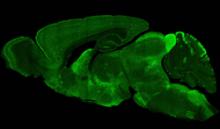Main Area of Focus

Eighteen newly developed lines of genetically engineered mice will provide neuroscientists with a powerful set of tools to explore the development of a class of neurons central to the organization and function of neural circuits in the brain. The mouse lines are the latest addition to the Cre Driver Network, an initiative to create a collection of mouse strains that offer scientists the ability to make precise alterations in brain-related genes as a way of exploring their impact on brain function. The network is funded by the NIH Blueprint for Neuroscience Research.
Background
The technology used to create mice for the Cre Driver Network involves the targeted insertion in the mouse genome of a gene for Cre recombinase, an enzyme that triggers the swapping, or recombination, of stretches of DNA in chromosomes. Cre offers several levels of control over recombination: both the insertion site of Cre and the recombination events it triggers can be precisely targeted; and it can be inserted in the genome in a way that scientists can induce recombination at a desired time and in selected cell populations. It offers a versatile way to study how patterns of gene activity, or gene expression, affect brain development. Further, these Cre drivers represent “genetic switches” that can turn on a growing variety of genetically encoded elements, enabling scientists to target specific neuron types in the analysis of neural circuit development, function, and dysfunction.
In creating these most recent mouse lines, a team led by Josh Huang at Cold Spring Harbor Laboratory in New York aimed to provide a way to explore the development and function of cortical GABAergic interneurons, which make up about 20 percent of the neurons in the brain’s cerebral cortex. By sending inhibitory signals to other neurons, GABAergic interneurons play important regulatory functions in neural circuits. Huang and his team created 18 unique mouse lines in which Cre was inserted so that its expression would mimic that of genes known to shape the emerging identity, function, and positioning of cortical GABAergic interneurons. Incorporating a “reporter” gene allowed the team to see precisely in which interneurons the Cre recombinase was active during development—and as a result, the gene whose activity it mirrored
Much research on the brain is focused on the development and function of neural circuits, networks of neurons that function in a coordinated way across the brain. Neural circuits are the foundation of integrated brain function; scientists are increasingly looking at how disruptions in the development of neural circuits underlie mental illness.
As the brain develops, progenitor cells take on specific identities at specific times, settle into place in organized layers of brain tissue, and ultimately become incorporated into neural circuits. The technology used to create these mice allows scientists to trace how genetic programs specify diverse neuron types and how brain cells assume their respective location and integrate into neuronal networks.
Cre technology can also be used to create knockout mice in which selected genes are deleted so that scientists can observe the effects of the gene’s absence. With Cre, deletions can be controlled precisely in terms of time and cell population. Timing is particularly important: knocking out a gene very early in development can sometimes be lethal.
Cre driver mice have not been widely available because creating them requires specialized expertise and is labor intensive. Huang's mice and other lines generated through the Cre Driver Network are being made available to the scientific community through public repositories, which will save research time and resources.
The mouse lines generated by Huang will be housed at The Jackson Laboratory’s Cre Repository at Bar Harbor, Maine. The Jackson Laboratory repository is one of two mutant mouse facilities funded by the Blueprint: the other is the Mutant Mouse Regional Resource Center at the University of Missouri, Columbia, Missouri. In addition to Cold Spring Harbor, two other teams are developing Cre-driver mice with Blueprint funding: The Scripps Research Institute in Jupiter, Florida, and Baylor College of Medicine, Houston, Texas.
Cre driver mice will enable a wide range of investigations into the genes that shape the development and function of the brain. The development of the 18 mouse lines described here was reported in the September 22, 2011 issue of the journal Neuron .
